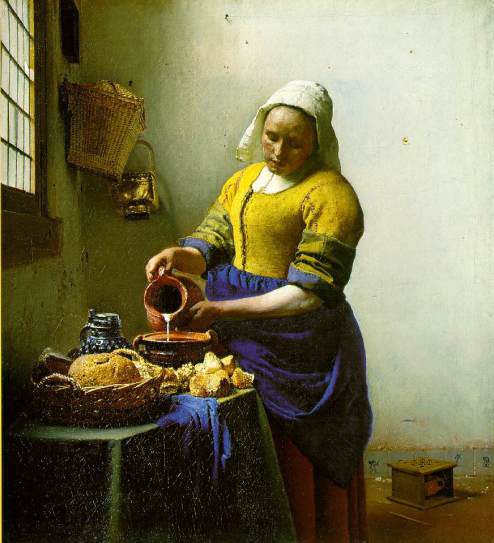
Vermeer: Milkmaid
Necessary moments of tranquility, rarely found. Vermeer painted only some forty pictures that we know and some of those are disputed. He was a Catholic artist in a Protestant country. I am not sure how much Protestantism allows for the visionary, the transfigurative. There is much to admire about Protestant humanity, honesty, plain speaking, and impatience with pretentious jiggery-pokery. Go to Rembrandt for the humanity. His sense of the divine is born of clay and human suffering. To Vermeer you go for something else. However ordinary his scenes appear they remain transfigurative. The question is what is being transfigured?
Time, for one thing. Vermeer offers us moments of such meditative concentration it seems a person could be quite lost in a simple action such as pouring a jug of milk. There are of course narrative elements that refer the viewer to sources beyond the scene, to other moments in time, but they are secondary. It is action that is transfigured into a form of grace. I call the concentration meditative, but it is not really clear that it is the subjects that are meditative: it is the meditativeness in the viewer that is invited to attend.
Here Vermeer has his favourite yellow-blue colour scheme. YOu'd pick him out anywhere just for that. He has his repoussoir table poking through the picture frame, as was often the case with Baroque painting. He has some Baroque tricks to do with light and composition - he is, after all, an artist of what art historians call the Baroque period - but he disdains Baroque drama. Nothing dramatic happens. Almost nothing happens. Except this pouring of milk. The rest is stories and pleasing the curious. Not just secondary, but tertiary, all but insignificant.
And when you get close to a Vermeer in real life, not in a reproduction, but the actual thing, you note his miraculous way with paint, a paint that is almost drops of pearl, pearl you can never quite focus. It defines then quietly rejects definition. It is mid-way between paint and depiction, that midpoint transformed into a way of seeing. And maybe that is where the transfiguration lies. It is another form of epiphany, the point at which the transcendent appears. Or we call it the transcendent. Or just 'our sense of the transcendent', because you can argue theology, for religion or against religion, as much as you like, we still have a sense of the epiphanic and recognise it when it presents itself: dramatically silent, focused, tranquil.

1 comment:
There's a beautiful discussion of this painting in Ciaran Carson's "Fishing for Amber," which I quote here:
http://andrewjshields.blogspot.com/2010/10/fishing-for-amber.html
Post a Comment